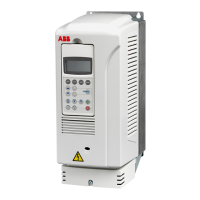162 Resistor braking
the drive selection also). The following condition must be met:
where
3. Check the resistor selection. The energy generated by the motor during a 400-
second period must not exceed the resistor heat dissipation capacity
E
R
.
If the
E
R
value is not sufficient, it is possible to use a four-resistor assembly in which two standard
resistors are connected in parallel, two in series. The
E
R
value of the four-resistor assembly is four
times the value specified for the standard resistor.
Note: A resistor other than the standard resistor can be used provided that:
• its resistance is not lower than the resistance of the standard resistor.
WARNING! Never use a brake resistor with a resistance below the value
specified for the particular drive / brake chopper / resistor combination.
The drive and the chopper are not able to handle the overcurrent caused by
the low resistance.
• the resistance does not restrict the braking capacity needed, that is,
where
• the heat dissipation capacity
(E
R
) is sufficient for the application (see step 3
above).
P
br
denotes
P
br5
,
P
br10
,
P
br30
,
P
br60
, or
P
brcont
depending on the duty cycle.
P
max
maximum power generated by the motor during braking
U
DC
voltage over the resistor during braking, for example,
1.35 · 1.2 · 415 V DC (when supply voltage is 380 to 415 V AC),
1.35 · 1.2 · 500 V DC. (when supply voltage is 440 to 500 V AC) or
1.35 · 1.2 · 690 V DC (when supply voltage is 525 to 690 V AC).
R resistor resistance (ohm)

